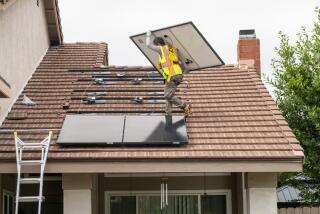DWP will buy excess solar energy
- Share via
Los Angeles Department of Water and Power customers for the first time will be able to sell back excess solar energy created on rooftops and parking lots under a new program approved Friday by the city utility’s board of commissioners.
Described as the largest urban rooftop solar program of its kind in the nation, the so-called feed-in-tariff program would pay customers 17 cents per kilowatt hour for energy produced on their own equipment. The DWP has already accepted more than a dozen applicants and will be taking dozens more as it accepts contracts for up to 100 megawatts of solar power through 2016.
Environmentalists, business supporters and solar vendors were thrilled by the vote. Feed-in-tariff programs help generate jobs and economic activity while decreasing greenhouse gas emissions, they say.
“Today’s vote is a major step forward for the economic and environmental sustainability of Los Angeles,” said Mary Leslie, President of the Los Angeles Business Council, a group advocating the Clean LA Solar program since 2009.
Fred Pickel, the city’s ratepayer advocate, told commissioners that 17 cents per kilowatt hour was above market rates and could force significant rate increases on DWP customers. Higher DWP bills could drive jobs away, Pickel told the board.
But the board unanimously decided to move ahead, and to reassess the program at regular intervals.
In March, the commission will decide whether to add an additional 50 megawatts of energy to the buyback program. The full 150-megawatt program would create enough solar energy to power 34,000 Los Angeles homes, advocates say.
Once qualified, DWP customers with large multi-family dwellings, warehouses, school facilities and parking lots can sell solar energy at 17 cents per kilowatt hour. The DWP is offering a tiered-pricing schedule that drops to 13 cents per kilowatt hour as energy contracts are reserved, DWP officials said.
Single-family homes generally don’t produce enough energy to qualify.
Some of the contracts will be set aside for smaller solar producers to give them a better chance at winning slots, officials said. Customers participating in other solar-incentive initiatives, such as net-metering, do not qualify for the buyback contracts, DWP officials said.
Environmental groups have long pushed for a feed-in-tariff, arguing that it would spur more commercial property owners to go solar. Sacramento and San Diego have their own versions, and Florida is experimenting with buybacks.
Evan Gillespie, campaign representative for the Sierra Club’s Beyond Coal Campaign, said the vote will allow the DWP to curtail its dependence on out-of-state energy generators. In addition, it promises 4,500 jobs and $500,000 in new economic activity for the city, he said.
“In the 21st century, it is simply unacceptable for 40% of L.A.’s energy to come from aging out-of-state polluting coal-fired power plants,” Gillespie said.
After the vote, Toronto-based Solar Provider Group announced that it would expand its operations in Los Angeles by opening an office and hiring 30 people. The company plans to invest up to $50 million by the end of 2016, said President Christian Wentzel.
“This program provides us with the stability we need to enter the U.S. solar market,” he said.
DWP staffers recommended a 17-cents-per-kilowatt-hour rate as a starting point to reflect the relatively higher cost of buying solar energy compared to other commodities. The cost of getting the program up and running will raise the average residential monthly electric bill by about 4 cents, according to a staff report.
The DWP will hire an administrator and about 30 other people to operate the program, but most of those costs will be reimbursed by program participants, the report said.
Expanding local solar power is a key strategy for the DWP to meet the state-mandated renewable energy level of 33% by 2020.
--
catherine.saillant@latimes.com
More to Read
Inside the business of entertainment
The Wide Shot brings you news, analysis and insights on everything from streaming wars to production — and what it all means for the future.
You may occasionally receive promotional content from the Los Angeles Times.











